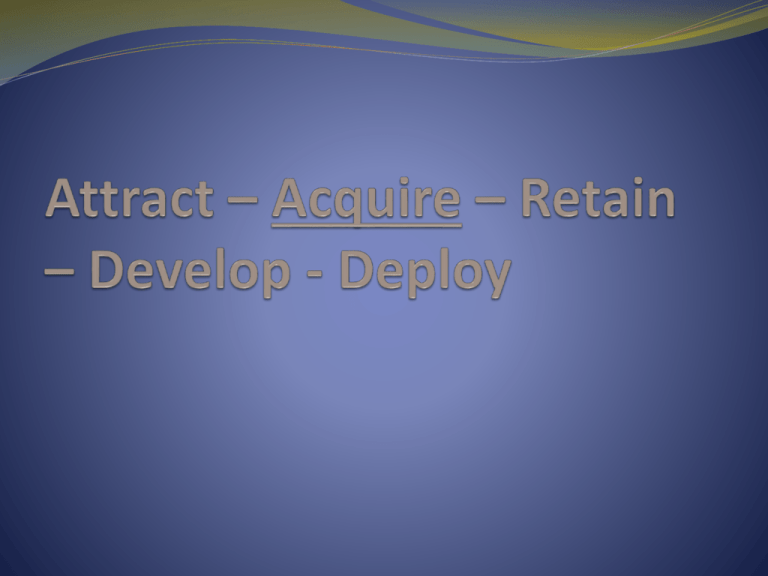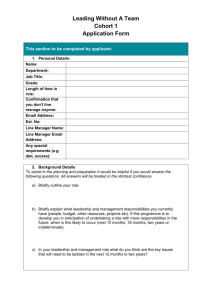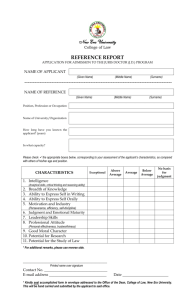
Selecting Human Resources
Like and archer who wounds at random is he
who hires a fool or any passer-by.
-Solomon
Module 3
Jack Welch (Winning) on Selection
“Nothing matters more in winning than getting the right people on the field. All the clever
strategies and advanced technologies in the world are nowhere near as effective without great
people to put them to work.”
Looking for Integrity
“You also have to rely on your gut. Does the person seem real? Does she openly admit mistakes? Does
he talk about his life with equal measures of candor and discretion?”
When hiring for the top:
“The first characteristic is authenticity. Why? It’s simple. A person cannot make hard decisions, hold
unpopular positions or stand tall for what he believes unless he knows who he is an feels comfortable
with that.”
“Every leader makes mistakes. Every leader stumbles and falls. The question for a senior level leader is:
does she learn from her mistakes, regroup, and them get going again with renewed speed, conviction
and confidence.”
Leaders are Readers
Peter Drucker (1974)- Management: Tasks,
Responsibilities, Practices
“An employer has no business with a man’s personality.
It is immoral as well as an illegal intrusion of privacy. It
is an abuse of power. Employment is a specific contract
calling for a specific performance…an employee owes
no “loyalty”, he owes no “love” and no “attitudes”—he
owes performance and nothing else.”
General Eric Shinseki
Shinseki
Top U.S. Army General. (retired)
Initiated Future Combat Systems and Stryker InterimForce Brigade Combat Teams (Urban warfare)
Accurately predicted Iraq requirements
When asked the number one attribute needed by
soldiers and commanders said “judgment”.
How do you hire this?
Perspectives
https://www.youtube.com/watch?v=Y7Zpm8OK3jY
Longer Video if interested:
https://www.youtube.com/watch?v=R9ki2SQdGT8
Selection and Placement
Selection
The process of choosing individuals with qualifications needed to fill jobs in an
organization.
Organizations need qualified employees to succeed.
“Hire hard, manage easy.”
“Good training will not make up for bad selection.”
The state (developable) or trait (stable) distinction
Placement
Fitting a person to the right job.
Target- Person-job Fit
Matching the knowledge, skills and abilities (KSAs) of people to the characteristics of
jobs (tasks, duties and responsibilities–TDRs).
Benefits of person-job fit
Higher employee performance
Lower turnover and absenteeism
Other types of fit:
Person-Organization fit- alignment with values and expectations
Person-Supervisor fit- alignment with preferred supervision style
Applicant Job Interest
Realistic Job Preview
The process through which a job applicant receives an
accurate picture of the organizational realities of the job.
Prevents the development of unrealistic job expectations that
cause disenchantment, dissatisfaction, and turnover in new
employees.
Refining the psychological contract with an RJP
Electronic Screening
Electronic Screening
Use applicant tracking
systems when:
The volume of applicants is large
The quality of hires needs to be increased
Hiring cycles need to be shortened
The cost of hiring needs to be reduced
The firm needs to reach geographic areas not visited by
recruiters
Applications
Purposes of Applications
Record of applicant’s interest in the job
Part of defining who is an applicant
Provides a profile of the applicant
Basic record for applicants who are hired
Research effectiveness of the selection process
Resumes as Applications
Resumes are applications for EEO purposes.
Resumes should be retained for at least three years.
Immigration Forms (Eligibility to Work)
INS I-9 form must be completed within 72 hours.
Application Disclaimers and
Notices
Employment-at-will
Indicates the right of the employer or employee to terminate the
employment relationship at any time with or without notice or
cause.
References
Obtain applicant’s permission to contact references on the application
itself.
Employment testing
Notifies applicants of required drug tests, physical exams, or other
tests.
Application time limits
Indicates how long the application will remain active.
Information falsification
Indicates that false information is grounds for termination.
EEO Considerations and
Application Forms
Applications should not contain illegal (nonjob-
related) questions concerning:
Marital status
Height/weight
Number and ages of dependents
Information on spouse
Date of high school graduation
Contact in case of emergency
Acceptable
Documents for
Verifying
Eligibility to Work
in the U.S.
Job Tests:
Legal Concerns and Selection Testing
Legal Concerns and Selection Testing
Job-relatedness (validity) of selection tests
(PERFORMANCE)
Reliability- tests the same thing over and over
Compliance with EEO and ADA laws and regulations
Proper Use of Tests in Selection
Use for additional information, not disqualification
Negative reactions by test takers to certain tests
Costs of testing versus “bad hires”
Example- strong relationship between
conscientiousness and absenteeism
Selection Testing: Ability Tests
Cognitive Ability
Tests
Physical Ability
Tests
Psychomotor
Tests
Ability Tests
Work Sample
Tests
Aptitude and
Achievement
Assessment
Centers
© 2011 Cengage Learning. All
rights reserved. May not be
scanned, copied or duplicated,
or posted to a publicly
accessible Web site, in whole
or in part.
7–15
Situational
Judgment Tests
Other Tests
Personality Tests
Minnesota Multiphasic Personality Inventory (MMPI)
Myers-Briggs
“Fakability” and personality tests
Honest/Integrity Tests
Socially desirable responses
False positives
Polygraph tests (“lie detector”)
The Employee Polygraph Protection Act prohibits preemployment testing (in most instances).
7–16
FIGURE 7–6
Big Five Personality
Characteristics
7–17
Controversies in Selection
Testing
General Mental Ability Testing
Minority groups tend to score lower on tests
Requires business necessity defense and validation.
Personality Testing
Explains very little about actual job outcomes.
7–18







